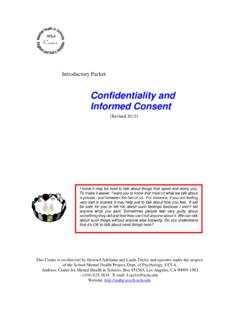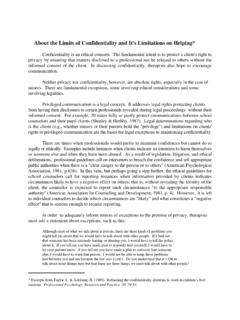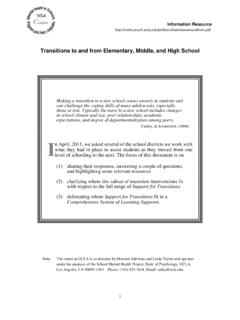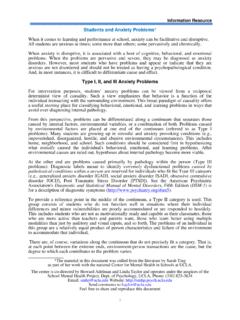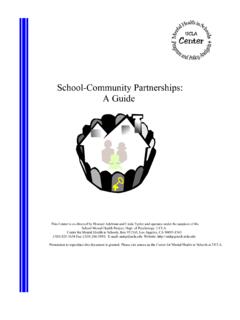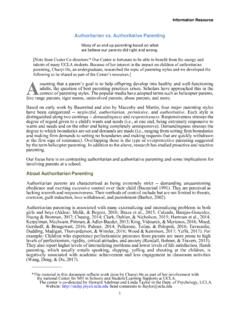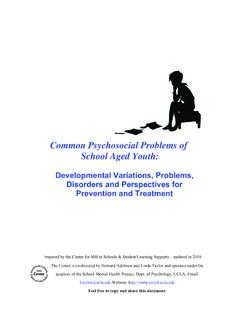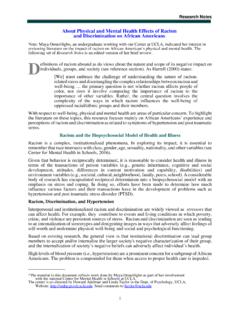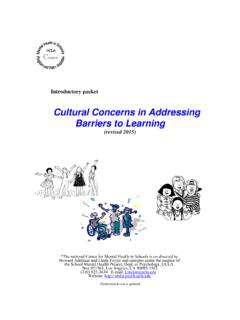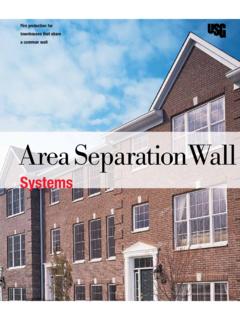Transcription of Promoting Positive Peer Relationships: A Sample of Recent ...
1 1 Information Resource Promoting Positive Peer Relationships: A Sample of Recent References* s the literature stresses, peers play a role in social development and learning related to empathy, caring, social responsibility, negotiation, persuasion, cooperation, compromise, emotional control , conflict resolution, and more. Peers also provide social and emotional support and are socialization agents who model and mold others behaviors and beliefs and solidify their own. The impact of peers begins with early learning. Peer relationships at school can facilitate or be a barrier to learning and teaching. Peer relationships can also function as helping interventions. Schools play both a passive and active role. To highlight all this and to add to the resources already on our Center s website, below is an annotated Sample of references. Most of the annotations are edited excerpts from authors abstracts and introductions.
2 Developing Peer Relationships at School >Peer relationships: Promoting Positive peer relationships during childhood (2014), Rohrbeck & Gray. In Gullotta & M. Bloom (Eds.), Encyclopedia of Primary Prevention and Health Promotion. New York: Springer. With regard to prevention and health promotion, peer relationships may be viewed as a valued outcome in their own right. In addition, Positive and negative peer relationships can predict later adaptive and problematic outcomes, respectively. Finally, peer relationships can also serve as risk or protective factors in the relationships among other variables, especially relationships between stressors ( , victimization) and outcomes such as depression. This resource provides an overview of strategies, programs with research support and those that are considered promising. > Promoting Positive peer relationships (2008), In H. Ming-tak & L. Wai-shing (Eds.), Classroom management: Creating a Positive learning environment. Hong Kong University Press.
3 This chapter highlights (a) the importance of good peer relationships in students' personal growth and academic success, (b) describes how students' conceptions of friendship change from primary to secondary education, and (c) outlines the characteristics of popular students. Some basic practices for Promoting students' popularity are given, with a practical framework for helping students with peer problems to take a new perspective and develop new patterns of behaviour for improving their relationships. Lastly, teachers can take a proactive approach in Promoting Positive peer relationships among students in the classroom by developing strategies in the following areas: teaching social-emotional skills, conflict-resolution skills and problem-solving skills; getting students to learn in groups; and creating a classroom climate of Positive peer relationships. *The material in this document was culled from the literature and a draft paper written by Quan Zhou (Emmy) as part of her work with the national Center for Mental Health in Schools at UCLA.
4 The center is co-directed by Howard Adelman and Linda Taylor and operates under the auspices of the School Mental Health Project, Dept. of Psychology, UCLA. Phone: (310) 825-3634 Email: Website: Send comments to A2 >Developing Positive relationships in schools (2011), S. Roffey. In S. Roffey (Ed.), Positive relationships: Evidence based practice across the world. New York: Springer. Positive relationships in schools are central to the well-being of both students and teachers and underpin an effective learning environment. There is now a wealth of research on the importance of connectedness in schools and on the specific qualities of in-school relationships that promote effective education. This chapter demonstrates that these are based in an ecological framework throughout the school system. What happens in one part of the school impacts on what happens elsewhere. The chapter explores what schools might do to increase the level of social capital and Positive relationships within the school community.
5 >Peer relationships as a context for the development of school engagement during early adolescence (2011), L. Yibing, Lynch, C. Kalvin, J. Liu, & Lerner, International Journal of Behavioral Development 35, 329 342. Peer support positively predicted behavioral and emotional school engagement, whereas associating with problem-behaving friends and bullying involvement were negatively associated with both aspects of school engagement. When students were older, the Positive influences of Positive peer support on emotional engagement appeared stronger. Similarly, the negative influences of associating with problem-behaving friends on behavioral engagement became more detrimental over time. While girls and youth of higher family socioeconomic status (SES) tended to be more behaviorally and emotionally engaged than boys and youth from less advantaged families, the influences of time and peer relationships on school engagement were not different for boys and girls or for youth with different family SES backgrounds.
6 Implications for understanding peer relations as a context for Promoting school engagement are discussed. >Teachers' attunement to students' peer group affiliations as a source of improved student experiences of the school social affective context following the middle school transition (2011), Hamm, Farmer, K. Dadisman, M. Gravelle, & Murray, Journal of Applied Developmental Psychology, 32, 267 277. A randomized control trial examined the impact of a professional development program on rural teachers' attunement to student social dynamics, and the influence of teacher attunement on students' school experiences. Students self-reported their perceptions of the school social affective context. Intervention and control schools differed on teacher attunement and management of the social environment. Students whose teachers were more attuned to peer group affiliations evidenced improved views of the school social environment. Findings are discussed in terms of attunement as an element of teachers' invisible hand, and for teachers' role in Promoting productive contexts for students during the middle school transition.
7 >Getting along: How teachers can support children's peer relationships (1997), K. M. Kemple & L. Hartle, Early Childhood Education Journal, 24, 139-146. Outlines the following set of practices for schools to encourage Positive peer interactions. 1. Foster a safe and respected emotional environment (democratic style of discipline, frequent use of children's name to help students recognize and memorize each other; lead discussion about individual interest and experience so that students can have a better understanding of each other and identification of shared interest; participate and guide in conversation to help children realize how they differ from each other) 2. Provide a suitable physical place (large enough to accommodate a group of students, provide adequate equipment such as tables, chairs, books, or snacks, provide a safe play area outside classroom) 3 3. Prepare accessible materials for all students to choose, and equipment that support children's social activities (provide materials that can meet students' interests, ,teachers can provide many color pencils and white papers to students who are interested in painting) 4.
8 Set up a schedule that allows for some free time to play (frequent change of schedule is not good for students to engage in social play; snack time is a good practice for students to talk and share food; teachers can participate during snack time to "model, guide, and encourage polite conversation" and sharing behavior) 5. Observe and help solve the conflicts (teachers do not need to engage in students' activities but are encouraged to observe them; if there are conflicts or bullying behaviors, teachers need to help solve these problems; if teachers' support is needed, especially during interaction among disabled students, teachers should step in and guide the interactions; discuss with students about when they had conflicts with others and how should they solve these problems). >Friendships, peer acceptance, and group membership: Relations to academic achievement in middle school (1997). Wentzel & K. Caldwell, Child Development, 65, 1198-1209. #page_scan_tab_contents Examines the correlation among between peer relationships and middle school students academic performance.
9 The three aspects of peer relationships addressed are reciprocal friendship, group membership, and peer acceptance. Some of the results: 1. There was a significant relation between peer acceptance and GPA in sixth grade. Peer acceptance was also significantly correlated with reciprocal friendship in sixth grade. 2. As for girls, groups membership was correlated with both six and seventh grade GPA. There was also a significant relation between peer acceptance and sixth and seventh grade GPA. 3. For boys, all three peer variables, except for reciprocal friendship, can predicate GPA in sixth grade. 4. For both boys and girls, there was a significant and Positive relationship between peer acceptance and reciprocal friendship. 5. For girls, reciprocal friendship was significantly correlated with emotional distress in sixth and eighth grade. 6. For boys, eighth grade GPA was positively correlated with prosocial behavior and peer acceptance during middle school year, and negatively linked with sixth and eighth grade antisocial behavior.
10 7. For girls, there was a significant correlation between group membership and peer acceptance, antisocial behavior in sixth grade, and reciprocal friendship. 8. For boys, there was a significant link between group membership and sixth grade antisocial behavior, eighth grade emotional distress and prosocial behavior. >A meta-analysis of the effects of face-to-face cooperative learning. Do Recent studies falsify or verify earlier findings? E. Kyndt, E. Raes, B. Lismont, F. Timmers , E. Cascallar, & F. Dochy (2013). Educational Research Review 10, 133 149. One of the major conclusive results of the research on learning in formal learning settings of the past decades is that cooperative learning has shown to evoke clear Positive effects on different variables. Therefore this meta-analysis has two principal aims. First, it tries to replicate, based on Recent studies, the research about the main effects of cooperative learning on three categories of outcomes: achievement, attitudes and perceptions.
